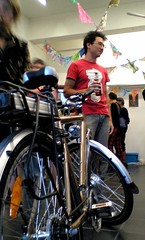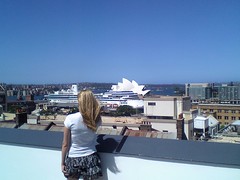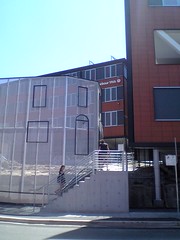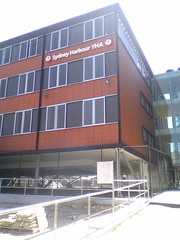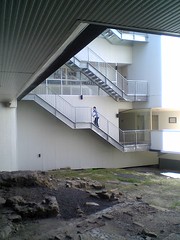I will be speaking on "
Optimising Sites for Mobile Devices and Search Engines" at the
WebForward Conference, 26 May 2010. Suggestions as to what to say and examples to use would be welcome. This is part of
CeBIT Australia in Sydney. I may also attend the
eGovernment Forum: Delivering open government on 25 May 2010.
Optimising Sites for Mobile Devices and Search Engines
by: Tom Worthington FACS HLM, Adjunct Senior Lecturer, Australian National University
Some simple tools and techniques can be used to allow any web site to be usable on a mobile phone and improve its rating with web search engines. These techniques can also help make your web site easier to understand for people using an ordinary web browser and particularly for use by older people.
Covered:
- Web Content Accessibility Guidelines
- Validation Tests
- W3C mobileOK Checker
- TAW Web Accessibility Test
Background
A set of tools and techniques have been developed to make the content of web pages more accessible. The best known of these are the W3C Web Content Accessibility Guidelines, with automated testing in the TAW Accessibility Tool. The use of such techniques is required by Australian anti-discrimination legislation, including by schools, TAFEs and universities in delivering education online. What is not well understood is that while these techniques are mandated for access by people with a disability, they can also be used to help with slow Internet connections, for limited devices such as mobile phones and for people with limited literacy.
There are additional guidelines and tools to help develop content for mobile devices, such as the W3C Mobile Web Best Practices and . Previously this required development of a second version of the content, specifically for mobile devices. However, as smart phones become more affordable, with larger screens and better software, it is possible to author the same content for education and service delivery to both desktop and mobile devices.
Providing accessible content and to mobile devices requires the web designer and the content author to make difficult decisions. Compromises must be made over what can be delivered and in what form. This can help make better content and better learning, by eliminating material which is entertaining, but not educational.
Bio:
Tom Worthington is an IT consultant and an Adjunct Senior Lecturer at the Australian National University, where he teaches the design of mobile web sites, e-commerce and green ICT. In 1999 he was elected a Fellow of the Australian Computer Society for his contribution to the development of public Internet policy.
Tom was an expert witness in the Human Rights Commission for the Sydney Olympics web case and was invited to Beging to adivse on the design od the web site for the 2008 Olympics. He is a past president, Fellow and Honorary Life Member of the Australian Computer Society, a voting member of the Association for Computing Machinery and a member of the Institute of Electrical and Electronics Engineers.
This stuff from my talk
looks relevant. I could have to change the examples from government to business:
Run a business on your phone, or a war * Technology which was in Australian and US DoD is now in your phone
* Use tools (W3C Mobile OK)
Exercise KANGAROO 95 took place in an area of over 4 million km square, across the Top End of Australia from July to the end of August 1995 and involved over 17,000 Australian Defence Force troops, and visiting units from the USA, Malaysia, Singapore, Papua New Guinea, the UK and Indonesia.
Reports and photographs were transmitted from the exercise area using stand-alone portable satellite communications terminals, capable of 64kbps.
As manager of the Defence home page, I received the reports at Defence headquarters in Canberra and up-loaded, them to a publicly accessible Internet server at the Australian Defence Force Academy.
For the first week of the exercise I was officially on holiday, but maintained the K95 home page remotely using a pocket 2400 pbs modem and lap top PC from Mallacoota, Victoria.
In later exercises, such as Tandem Thrust 97 made more use of the Internet for the operations. However, the level of technology used in these exercises is similar to that now available in a 3G smart phone for about $1,000.
E-mail, the web and instant messaging can be used for business and government from a smart phone with a little forethought. Check your business web pages are mobile compatible. Make sure you put the important business information in a simple, clear, easy to read format. Don't use software and technology you don't really need.
Web 2.0 Thinking Needed * Early simple web pages are compatible with mobile phones
* Later web design lost mobile compatibility
* New CSS features allow for desktop/mobile compatibility
* Need web 2.0 thinking by organisations
The processing power and network bandwidth of the laptop and desktop computers used for exercise KANGAROO 95 in 1995 is comparable with what is available from 3G smart phones in 2009. However, the use of these devices is being held up by poor web design.
Web pages design in 1995 were text rich, with small images and limited layouts. These designs are compatible with today's smart phones. Later more complex web page designs lost this compatibility, due to their complex designs and increased file sizes.
Also web based services need to be designed as services, not as marketing brochures. CSS features supported in modern web browsers allow for web 2.0 features, but organisations need to accept that their staff and their clients will want to be involved in decision making. Effort therefore need to be put into clear, detailed, information rich web sites.
Mobile Thinking * What not to do: Big hard to read e-documents. (Consulting with Government online)
* What to do: accessible and mobile friendly (Online Consultation Guidelines)
* Don't intimidate with legalese: Government copyright notice
* Use open access: outdated, use Creative Commons
* Example: Public Sphere #2 – Government 2.0: Policy and Practice
Thinking about interaction with via a mobile device can help you think about how and what to communicate. The limitations in screen size and keyboard access force you to focus on the most important information first.
Some impediments to the use of the technology can be easily removed. As an example, in 2008 the Department of Finance and Deregulation issued a report on "Consulting with Government – online". This was a well reasoned exploration of the issues. However, the report was only issued as large, hard to read online PDF and RTF files.
The Online Consultation Guidelines from the Australian Government Information Management Office (AGIMO) are reasonably accessible and mobile friendly. The home page achieves a 80/100 score on the W3C mobileOK Checker. However, discussion of the document is still hampered by a Commonwealth Copyright Notice.
The Commonwealth Copyright notice used for web pages is essentially unchanged from the Department of Defence web copyright notice developed in 1995. The Australian Government should adopt the Australian Creative Commons Licence, or similar, to allow the free discussion of issues. Similarly, companies should check the licences they impose on information distributed. If you want your product details out there being discussed, don't make it hard.
Labels: CEBIT, mobile web, Sydney, Web Search



